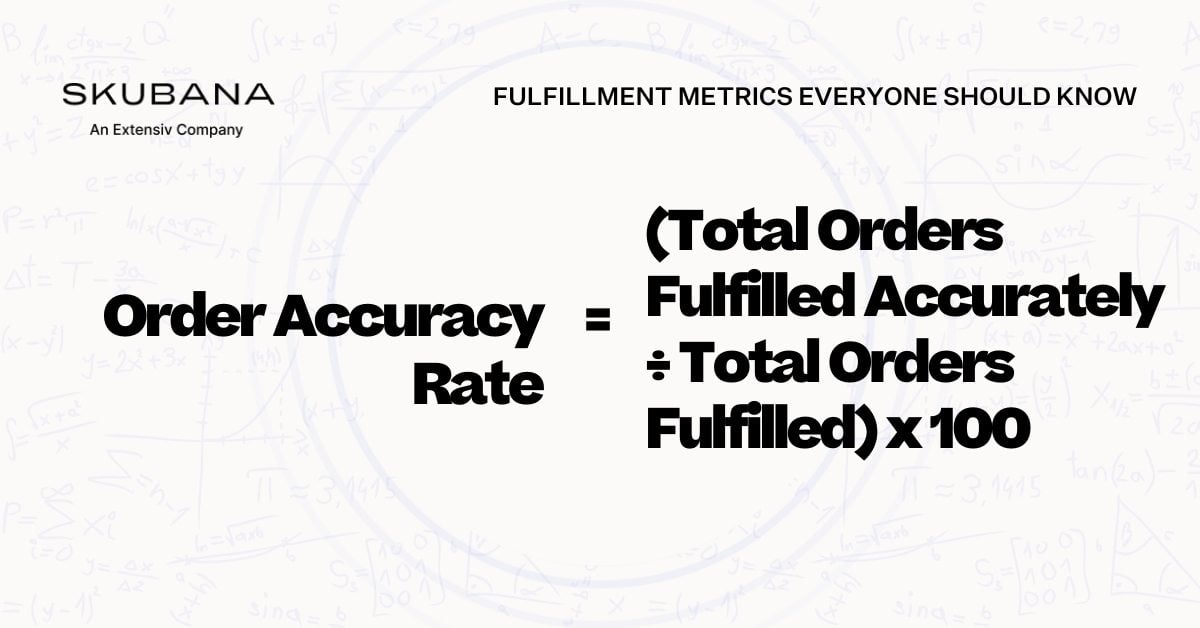Order accuracy refers to the precision and correctness of fulfilling an order, ensuring that the items requested by the customer are delivered correctly and without errors. It is one of the best metrics ecommerce retailers can track, as this measurement impacts the level of trust between a brand and their customers. Taking small, yet strategic steps to improve order accuracy can offer incredible benefits for your business — from fewer errors and reduced costs, to increased profitability and greater customer satisfaction.
What is order accuracy?
Order accuracy is the percentage of orders that are fulfilled correctly and delivered to the right customer on time and without errors. A high order accuracy rate indicates that the majority of your customers receive the exact items they ordered, and in top condition upon arrival.
Order accuracy is an important metric to follow because it demonstrates how successful your brand is in giving customers what they want. In other words, order accuracy is directly tied to your customer satisfaction levels — and ultimately, to your customer retention.
How to calculate order accuracy

Order accuracy is vital to the health (and wealth) of your product-based brand. In fact, this metric is so valuable, it’s recommended that retailers continuously monitor their order accuracy rate so they can work to improve it as quickly as possible.
To calculate order accuracy for your own business, you’ll need to know the number of accurate orders your team has fulfilled. Once you have this number, you can divide it by the total orders fulfilled, and then multiply that answer by 100 (to give you a percentage).
More simply, the order accuracy formula is:
order accuracy rate = [total orders fulfilled accurately ÷ total orders fulfilled] x 100
Let’s say your brand has fulfilled 1,000 total orders. Of those 1,000 orders, 20 involved some sort of mistake. In this scenario, your order accuracy comes in at 98%.
order accuracy rate = [980 ÷ 1000] x 100 = 98%
So, is 98 a strong percentage, or one that’s in need of improvement? Read on to find out.
How to interpret your order accuracy rate

The end-to-end order fulfillment process involves tons of different moving parts, including a good deal of human intervention/interaction. With so many variables and external factors coming into play, it’s no surprise that reaching 100% order accuracy can be a challenge.
But even though flawless fulfillment is not always realistic, brands should still try to get as close to 100% accuracy as they can. With that in mind, a score that falls between 96 and 98% is considered strong (and is easily attainable for most online stores).
If your business lands within that range, then improving your order accuracy — even by one percent — can give you a competitive advantage over other retailers in your industry.
However, if your business is scoring 95% (or below), then you’re actually going to find yourself at a competitive disadvantage. In this case, it’ll be imperative to improve your order accuracy so you don’t discourage a single customer from purchasing with you again.
What bad order accuracy can do to a business

Now that you know how to interpret your order accuracy rate, you might be curious why a low score is so bad for your business. Well, the short answer is that incorrect orders prevent you from providing an exceptional customer experience (which comes with a number of consequences of its own, unfortunately).
According to the Pareto principle (a well-known customer success law), a whopping 80% of your company’s profits comes from just 20% of your customer base. To put it another way, “repeat customers generate revenue that is nearly 16 times more efficient than one-time customers.”
As you can likely infer from these statistics, building customer loyalty is paramount to your brand’s long-term success. But to secure this kind of loyalty from your customers, you’re going to have to offer superior service — which includes increasing your order accuracy.
Like it or not, order fulfillment errors are one of the leading causes of customer complaints. When customers receive the wrong product quantities (or the wrong SKUs altogether), it undoubtedly results in a bad experience and creates a bad impression of your brand.
What’s worse, after just one bad experience around 80% of consumers say they’d rather do business with a competitor than give your company another shot — and that goes for both new customers and returning shoppers.
So not only does poor order accuracy create negative customer perceptions, but it costs your company a lot of money, as well. Incorrect orders are also really time-consuming, since your team has to spend extra hours trying to make things right.
For all of these reasons, it’s necessary that your brand learns how to increase its order accuracy. In doing so, you can lock in customer loyalty and boost your bottom line in a sustainable way.
4 questions for better order accuracy

Speaking of increasing order accuracy, there are a handful of questions you can ask to help move this process along. By taking time to consider the following questions, you can set yourself on the path toward improved order accuracy and a more satisfied customer base.
1. Do you have clear goals?
Goal setting is an irreplaceable part of any order fulfillment strategy. Without a clear vision in place, you won’t know when you’re hitting your order accuracy targets or whether your fulfillment provider is operating at their highest capacity.
Keep in mind that before you can settle on any goals, you’ll need to know your current order accuracy rate. From there, you can create objectives you want to achieve within a designated time frame (following specific action items). For example, if your order accuracy rate hovers around 90%, you can make it a goal to move up to 95% by the end of the year.
2. How to improve the existing inventory process?
Did you know your inventory management process has a direct impact on the accuracy of your order picking? The reality is, most inaccurate orders stem from either a disorganized warehouse or a lack of inventory control — meaning you don’t have the stock you need to fulfill incoming customer orders.
Without a doubt, the best way to improve upon your inventory management is with the help of a proficient inventory software, like Extensiv.
Skubana’s multifaceted inventory and order management platform supports ecommerce retailers in tracking their inventory levels, forecasting future demand, and automating repetitive tasks such as reorder points and replenishment recommendations.
This way, your brand can avoid dreaded stockout situations and better ensure you have the inventory needed to fulfill orders accurately and on time.
3. Is your picking and packing procedure optimized?
As we alluded to above, most order processing errors happen at some point during the picking and packing process. With that said, it’s in your brand’s best interest to evaluate all the areas of improvement across your various distribution centers or fulfillment warehouses. Prioritizing these evaluations can lower your order error rates to a significant degree.
In the same way, check that your picking and packing process is fully streamlined within your greater fulfillment operations. One of the most popular methods for picking and packing optimization is called warehouse slotting. In essence, warehouse slotting stores your inventory wherever (and however) it makes most sense for the picker — which could mean products are categorized by type, size, weight, and so on.
When done correctly, slotting has a really positive effect on picking accuracy (simply by eliminating any confusion for the picker). And when there’s less confusion around picking, your team can work even faster since they’re no longer wasting time trying to find what they need.
4. Have you tried automation?
Although we touched on the importance and convenience of automation, it’s definitely worth mentioning again. That’s because automated software and fulfillment center technology can improve your order accuracy almost right out of the gate.
Using an order management system or warehouse management system (WMS) is one of the best ways to reduce the manual work required to fulfill customer orders. And as you may have already guessed, the less manual work at your warehouse, the less errors you’ll encounter.
Partnering with a warehouse management system allows you to automate processes that support picking speed and packing accuracy — but it also facilitates quality checks throughout the entire fulfillment process. What’s more, a WMS provides real-time visibility into your stock levels, storage capacity, and fluctuating workflows at your warehouse.
With this incredible awareness around order fulfillment, you can quickly identify what needs improvement (all without having to perform manual warehousing audits).
Tracking fulfillment KPIs to improve order accuracy

In addition to asking questions about your goals and procedures, you can likewise track a number of fulfillment KPIs (Key Performance Indicators) to measure order accuracy and improve it.
Among the best KPIs in this scenario are inventory turnover, average order value, return rate, average shipping time, and order picking accuracy.
Inventory turnover
Inventory turnover describes the rate at which your inventory is sold (or used) and replaced. When inventory turnover is high, it typically means there’s strong demand for your products. Conversely, when turnover is low, it typically indicates declining demand for what you sell.
A major benefit of inventory turnover is that it can tell you how well your company is managing its stock. If you’ve overestimated demand for a certain SKU (and thus, overstocked that product), it can manifest as low inventory turnover. On the other hand, a high turnover rate could mean you have insufficient inventory to fulfill customer orders.
If/when you do run into insufficient inventory, it’s going to negatively affect your order accuracy. That’s why you’re encouraged to keep a close eye on your turnover ratio, as this metric has a huge influence on your ability to accurately fulfill all items within an order.
Average order value
Average order value (AOV) is the average dollar amount a single customer spends on your website or mobile app. More specifically, AOV looks at the average dollar amount of every order placed over a specified period of time. This metric is one of the most important benchmarks for ecommerce retailers, as it drives decision-making related to ad spend and product pricing.
Calculating AOV also allows you to analyze consumer behavior and get a better understanding of the buying trends for online shoppers. With this information, you can make more informed forecasting decisions to ensure you always have the products your customers want.
Ultimately, this preparedness will improve your order accuracy rate, since you’re more likely to have the inventory you need in stock and ready to ship.
Return rate
Return rate is the percentage of orders that are returned by the customer who purchased them. Although returns can happen for a whole slew of reasons, they’re often the result of order inaccuracies. For example, if a customer receives an item in the wrong size or color, they’re apt to send that item right back to your company.
While such mistakes sometimes result in an exchange, many customers will ask for a full refund following a wrong order. In this instance, not only does your company lose that sale, but you might also lose that customer out of frustration or disappointment with your brand.
When you know your return rate, you can optimize returns management to boost satisfaction and hopefully retain a customer you might’ve otherwise lost.
A high return rate should empower you to figure out what exactly is going on. By taking the time to improve the mistakes or inefficiencies that are triggering so many returns, you can subsequently improve your order accuracy, as well.
Average shipping time
Average shipping time is the average time required to complete delivery within a designated period. To calculate average shipping time, you’ll divide the total shipping time by whichever time metric you use — days, weeks, months, quarters, or years.
This particular KPI can help you track the effectiveness of your supply chain and your planned delivery routes. Along with that, average shipping time can tell you whether deliveries are happening as scheduled or if you’re experiencing delays in fulfillment.
As you probably know, reliable shipping times make for a better customer experience. But did you know shipping times also play a part in your order accuracy?
Because order accuracy describes the consistency between what a customer orders and what is delivered, shipping times are factored into this equation. So for an order to be considered accurate, it must be delivered to the right address at the right time.
From that perspective, refining your shipping times goes hand in hand with perfecting your order accuracy rate, too.
Order picking accuracy
Order picking accuracy (OPA) indicates how often your shipments contain the correct goods and materials. To calculate order picking accuracy, you’ll take the total number of orders picked and verified to be accurate (prior to shipment), and divide that by the total number of orders picked over the same time period (expressed as a percentage).
Finding your OPA gives you a chance to identify error-prone processes and then take the necessary, corrective actions to enhance this fulfillment metric.
A low value for this KPI could suggest you need to work on your quality control standards, or that you need to retrain your employees on the appropriate picking procedures. With that said, repairing your OPA can do wonders to increase order accuracy, accelerate your profitability, and build customer retention for your brand.
Using Extensiv to Improve Your Order Accuracy
Extensiv’s order manager helps guarantee sales orders are consistently fulfilled accurately. As your business grows and you see a higher volume of orders, human errors are much more likely to occur if you’re still relying on manual processes. But by incorporating an order management system, you can receive and ship the correct product with ease and efficiency.
With Extensiv Order Manager, you can build, optimize, and breakdown bundles and kits into core components, monitor profitability on an SKU-by-SKU basis, and so much more. In other words, your sales, inventory, and analytics are all programmed within a single, comprehensive dashboard — thus removing the need for error-prone manual entry and periodic data transfers.
-
You’ll read about:
Be the first to know
Subscribe to our newsletter





